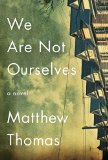Summary | Excerpt | Reading Guide | Reviews | Beyond the Book | Read-Alikes | Genres & Themes | Author Bio

This article relates to We Are Not Ourselves
In We Are Not Ourselves, Eileen Leary moves to a three-family home in Jackson Heights in Queens, New York, which, even as she watches, becomes increasingly diverse. "Supposedly it was the most ethnically diverse square mile in the world. Someone more poetically inclined might find inspiration in the polyphony of voices, but she just wanted to be surrounded by people who looked like her family," Matthew Thomas writes about Eileen's subtle racism. Attitudes such as this, many argue, were part of a complex mix of factors that drove white people to the suburbs in the mid-twentieth century.
 A vibrant post-WWII economy meant the expansion of the American dream for the middle class with government-subsidized mortgages readily available to white people. But white flight was fueled by additional factors as well. The forced desegregation brought about by Brown vs. Board of Education in 1954 meant that inner city whites set up private schools of their own (often in the suburbs) which didn't have to follow the letter of the law. Also the growth of the highway system and the automobile allowed white people to move to suburbs and commute to jobs. Highway construction, with overpasses that looped over inner cities, served to further isolate inner-city neighborhoods. Decreased access to highways, which were a vital conduit to a booming economy, meant fewer businesses in these already impoverished neighborhoods. This in turn meant a weaker tax base and, in an endlessly looping cycle, more urban decay.
A vibrant post-WWII economy meant the expansion of the American dream for the middle class with government-subsidized mortgages readily available to white people. But white flight was fueled by additional factors as well. The forced desegregation brought about by Brown vs. Board of Education in 1954 meant that inner city whites set up private schools of their own (often in the suburbs) which didn't have to follow the letter of the law. Also the growth of the highway system and the automobile allowed white people to move to suburbs and commute to jobs. Highway construction, with overpasses that looped over inner cities, served to further isolate inner-city neighborhoods. Decreased access to highways, which were a vital conduit to a booming economy, meant fewer businesses in these already impoverished neighborhoods. This in turn meant a weaker tax base and, in an endlessly looping cycle, more urban decay.
 A profitable practice called blockbusting accelerated inner-city problems. To sow the seed of white flight, a real estate agent would sometimes buy a house in a block and then resell it to a black family. Worried about falling home values because of their new neighbor, the rest of the white families in the inner city neighborhood would often sell their own houses at a loss and flee to the suburbs. As the white population moved away from the cities, so too did jobs and a more robust tax base. Complete collapse of the urban tax infrastructure lead to extreme problems as exemplified by the likes of Detroit, which is still struggling to get out of bankruptcy.
A profitable practice called blockbusting accelerated inner-city problems. To sow the seed of white flight, a real estate agent would sometimes buy a house in a block and then resell it to a black family. Worried about falling home values because of their new neighbor, the rest of the white families in the inner city neighborhood would often sell their own houses at a loss and flee to the suburbs. As the white population moved away from the cities, so too did jobs and a more robust tax base. Complete collapse of the urban tax infrastructure lead to extreme problems as exemplified by the likes of Detroit, which is still struggling to get out of bankruptcy.
Recent shifts have pointed to a trend reversal in many cities with young professionals choosing, for environmentally conscious reasons or otherwise, to live close to jobs in the city. The gentrification of many cities has been underway from the 1990s on.
You can trace the migration patterns of Americans in this article, which includes an interactive map.
The archetypal suburb: Levittown, NY 1950s, courtesy of affordablehousinginstitute.org.
Urban decay in the South Bronx in the 70s and 80s, courtesy of John Fekner.
Filed under Society and Politics
![]() This article relates to We Are Not Ourselves.
It first ran in the August 13, 2014
issue of BookBrowse Recommends.
This article relates to We Are Not Ourselves.
It first ran in the August 13, 2014
issue of BookBrowse Recommends.
Being slightly paranoid is like being slightly pregnant – it tends to get worse.
Click Here to find out who said this, as well as discovering other famous literary quotes!
Your guide toexceptional books
BookBrowse seeks out and recommends the best in contemporary fiction and nonfiction—books that not only engage and entertain but also deepen our understanding of ourselves and the world around us.